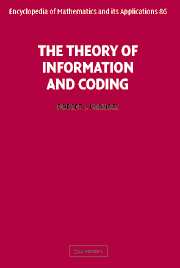Book contents
- Frontmatter
- Contents
- Editor's statement
- Section editor's foreword
- Preface to the first edition
- Preface to the second edition
- Introduction
- Part one Information theory
- Part two Coding theory
- 7 Linear codes
- 8 Cyclic codes
- 9 BCH, Reed–Solomon, and related codes
- 10 Convolutional codes
- 11 Variable-length source coding
- 12 Survey of advanced topics for Part two
- Appendices
- References
- Index of Theorems
- Index
8 - Cyclic codes
from Part two - Coding theory
Published online by Cambridge University Press: 10 November 2009
- Frontmatter
- Contents
- Editor's statement
- Section editor's foreword
- Preface to the first edition
- Preface to the second edition
- Introduction
- Part one Information theory
- Part two Coding theory
- 7 Linear codes
- 8 Cyclic codes
- 9 BCH, Reed–Solomon, and related codes
- 10 Convolutional codes
- 11 Variable-length source coding
- 12 Survey of advanced topics for Part two
- Appendices
- References
- Index of Theorems
- Index
Summary
Introduction
At the beginning of Chapter 7, we said that by restricting our attention to linear codes (rather than arbitrary, unstructured codes), we could hope to find some good codes which are reasonably easy to implement. And it is true that (via syndrome decoding, for example) a “small” linear code, say with dimension or redundancy at most 20, can be implemented in hardware without much difficulty. However, in order to obtain the performance promised by Shannon's theorems, it is necessary to use larger codes, and in general, a large code, even if it is linear, will be difficult to implement. For this reason, almost all block codes used in practice are in fact cyclic codes; cyclic codes form a very small and highly structured subset of the set of linear codes. In this chapter, we will give a general introduction to cyclic codes, discussing both the underlying mathematical theory (Section 8.1) and the basic hardware circuits used to implement cyclic codes (Section 8.2). In Section 8.3 we will show that Hamming codes can be implemented as cyclic codes, and in Sections 8.4 and 8.5 we will see how cyclic codes are used to combat burst errors. Our story will be continued in Chapter 9, where we will study the most important family of cyclic codes yet discovered: the BCH/ Reed–Solomon family.
We begin our studies with the innocuous-appearing definition of the class of cyclic codes.
- Type
- Chapter
- Information
- The Theory of Information and Coding , pp. 167 - 229Publisher: Cambridge University PressPrint publication year: 2002

